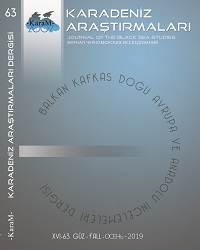Güvenlikleştirme Kuramı Açısından Transdinyester Sorunu
The Transdnistria Conflict in Terms of Securitization Theory
Author(s): Selim Kurt, İbragim KhasanovSubject(s): Security and defense, Post-War period (1950 - 1989), Inter-Ethnic Relations, Politics and Identity, Peace and Conflict Studies
Published by: Karadeniz Araştırmaları Merkezi
Keywords: The Transnistria Conflict; Securitization; Societal Security; Moldova; Identity;
Summary/Abstract: The Transnistria conflict, which dates back to old times, is a dispute that turned into a hot conflict within the Soviet Socialist Republic of Moldova in the late 1980s, when the Soviet Union showed signs of disintegration. It is seen as a territorial dispute. However, the Russian administrations have played an important role in the emergence of this problem in historical process. One of the main reasons for the problem was that settlement of Russian and Slavic populations by Tsarist Russia into today’s Moldova lands following the conquest of it in the 18th century. For this reason, the Securitization Theory, developed by the representatives of Copenhagen School, was preferred in this study instead of classical security studies, which take the state as the main reference object and see military threats as the most important threat category for the security of the state. Also, Societal Security, which is a sub-sector of this theory, added identity among its referent objects, and included in its analyses threats such as “immigration”, “horizontal competition” and “vertical competition”, which are considered among the factors that form the basis of separatism problem in Moldova. As a result of the examination it was found out that the conflict is fundamentally an identity based, and it was rooted in the transformation of the ethnical structure of the region by Slav immigration promoted by Russians to the detriment of Romanians, who constitute today’s ethnic Moldavian population.
Journal: Karadeniz Araştırmaları
- Issue Year: 2019
- Issue No: 63
- Page Range: 417-434
- Page Count: 18
- Language: Turkish

